Theoretical Design Approach of Distributed Satellite for Weather Monitering
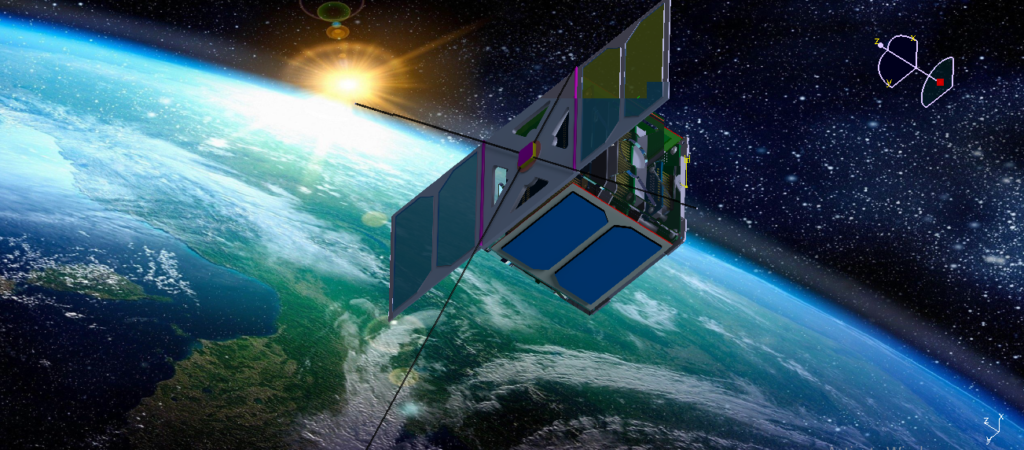
Abstract
Weather conditions are the state of the atmosphere at a specific time and location with respect to temperature, moisture, atmospheric pressure, precipitation, etc. It is therefore important to know the atmospheric condition for different applications. The interest is to design an autonomous small cube satellite, which can provide information about weather from anywhere without using the Network. Here a hardware model has been conceptualized and designed. It is possible to provide an instant weather report, which can be used to compare the data of a place with some different altitudes as well as for different time instants. In meteorology, the primary objective is to know exact weather conditions with less human effort, reliable and effective data. Because weather conditions vary from one location to another and depending on altitude, it is difficult to obtain specific weather conditions for a given location. With the advancement of technology, especially embedded systems & data acquisition systems, the problem of large setup areas and cost has been reduced significantly. CubeSat can be installed in the atmosphere or space, providing accurate weather.
Key Words: Data Acquisition, Radiation tolerance, Eclipse ,Magnetometer, UHF transceiver.
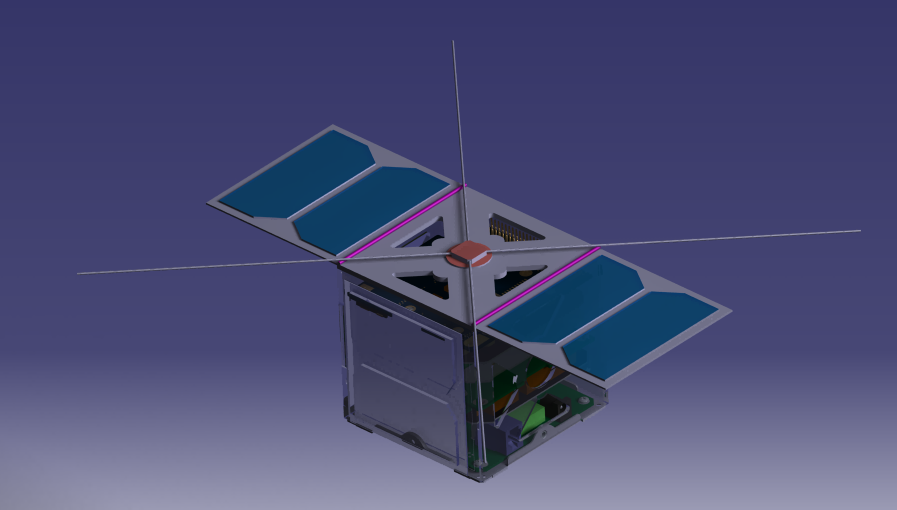
Structural Design of CubeSat
Structure Material Selection:
The adopted structures for CubeSat designs have become quite mature in recent years. However, they inherit a fixed construction approach. The materials used for structural purposes are basically aluminum alloys for aeronautical applications, 7075 and 6061, as well as austenitic stainless steel, A2 and A4. However, aluminum materials must be surface-treated with a hard anodized coating, which is non-conductive, in order to prevent cold welding and corrosion, and also aluminum avoids magnetic field disturbances with it provides ease of fabrication, low cost, and excellent mechanical properties that guarantee they withstand the stresses imposed during all the phases of a space mission. Considering all these properties we selected Al7075 T651 material having 3mm thickness. Properties of the Al7075 T651 are summarized in Fig.
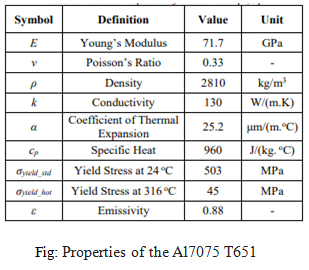
Thermal Insulation
The main function of the thermal control subsystem is to maintain all spacecraft and payload components and subsystems within their required temperature limits for each mission phase. For temperature control, two limits are frequently defined: “operational limits” that the component must remain within while operating and “survival limits” that the component must remain within at all times, even when not powered. For our CubeSat 8 layers of 0.25 mil, double aluminized Mylar are separated by Dacron polyester nets. A 2-mil aluminized second surface Kapton, coated with Indium Tin Oxide (TTO), is placed on top to face the space UV radiation and atomic oxygen environment. A 1 -mil double aluminized Kapton is located at the bottom to shield the spacecraft also it is commonly used as radiators to dump the spacecraft internally generated heat to the deep space.
Structure Design
For the CubeSat frame, Aluminum 7075 or 6061-T6 is suggested for the main structure. If other materials are used, the thermal expansion coefficient must be similar to that of Anodized Aluminum 7075-T3. It has properties like good corrosion resistance, avoiding stay light in optical equipment, scratch-resistant, good surface finish, and low weight as compared to others.
Finite Element Model
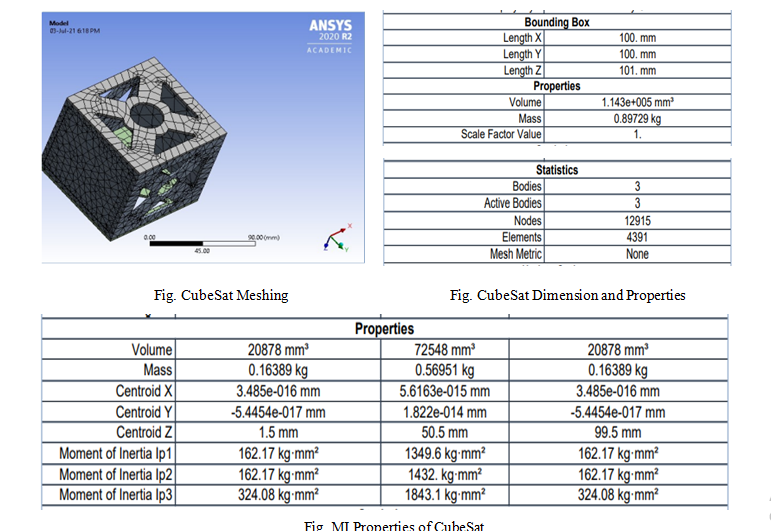
Equivalent Stress Analysis
According to the finite element analysis results, the highest stress level on the cubesat structure governing from the launching loads is determined as 459.8 MPa. Considering the yield stress of the material is 503 MPa for standard atmospheric conditions, the factor of safety value for the quasi-static launch analysis is found as 503/459.8 = 1.09 approximately that is acceptable.
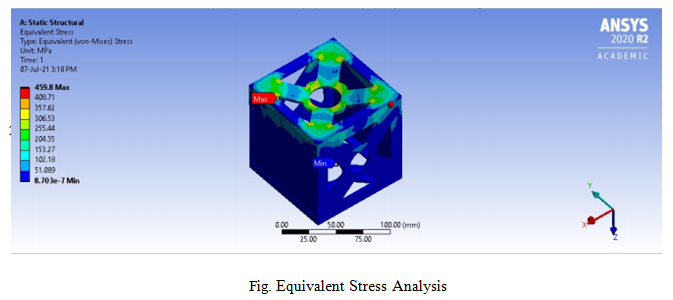
Equivalent Elastic Strain
The overall Equivalent Elastic Strain observed with a maximum value was 0.0023008 with a minimum value of 2.947e-011 and an overall Avg. value of 0.0002744, which is considered safe and acceptable.

Maximum Principle Stress
The overall Maximum Principal Stress acting on CubeSat during launch is 401.39Mpa. Considering the yield stress of the material is 503 MPa for standard atmospheric conditions, the factor of safety value for the Maximum Principal Stress is found as 503/401.39 = 1.253 approximately that is acceptable.

Maximum Principle Elastic Strain

Total Deformation and Directional Deformation
The total deformation observed during an average loading of 70 MPa was observed of 0.56043mm with an average value of 3.5867e-002 with Directional Deformation (X-Axis) value of 0.08013mm, which is almost negligible and acceptable as the deformation occurs within elastic range and is considered safe.

Strain Energy and Volume
The overall Strain Energy during Static Structural Analysis with a maximum value recorded was 11.29mj and overall volume change observed during launch was 257.62mm3, where in this value was used for safe payload design and component arrangement.

Weather CubeSat

Fig. Exploded view of weather CubeSat

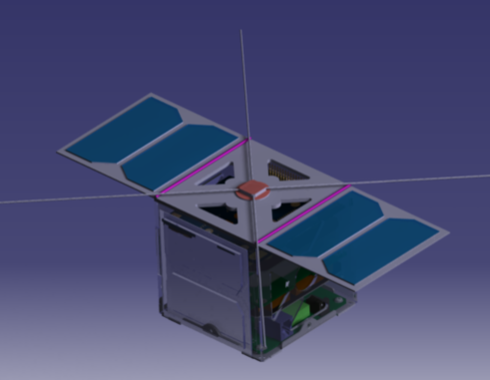
Fig. Assembly of CubeSat
Tools Used
- Hardware Design: Catia
- Structural Analysis: Ansys
Acknowledgement
I would like to thank BRAHMASTRA ORGANISATION for conducting the Internship and inspiring us to learn about CubeSat. I would also like to thank the Founder Subash P Kuppusamy for helping us learn beyond the college curriculum. I would like to express my gratitude to our mentors Manoj M Ganesan, Vennela Chowdary, Kathiravan Thangavel, and Sasi Kiran Palateerdham for the training sessions without whom we wouldn’t have been able to complete our project and make this report. Special thanks to entire team memebers for all their hard work.